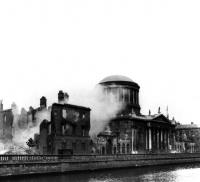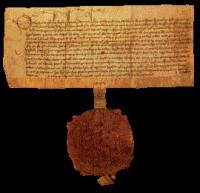The past as a bucket of ashes? CIRCLE:a Calendar of IRish Chancery LEtters, c. 1244-1509
Published in Features, Issue 4 (July/August 2011), Medieval History (pre-1500), Volume 19
The Four Courts under bombardment. The explosion that ripped through its Public Record Office on 30 June 1922 destroyed much of Ireland’s documentary heritage dating back to the early thirteenth century. (RTÉ Cashman Collection)
‘I tell you the past is a bucket of ashes’, wrote the American poet Carl Sandberg. For Irish historians this line rings true quite literally. The explosion that ripped through the Public Record Office of Ireland at the Four Courts, Dublin, on 30 June 1922 destroyed much of Ireland’s documentary heritage dating back to the early thirteenth century. As the Irish Times lamented on 3 July 1922, even before the ashes had cooled,
‘Those precious records, which would have been so useful to the future historian, have been devoured by the flames or scattered in fragments by the four winds of heaven’.
The losses were particularly acute for late medieval Irish history, which at the time of the disaster was arguably the most dynamic and professional sub-discipline within Irish historical studies as a whole. Among the most important classes of record destroyed were the rolls of the medieval Irish chancery, the secretariat of the kings of England, responsible for issuing letters in the king’s name under the great seal of Ireland. Copies of many of these outgoing letters were transcribed painstakingly by the medieval chancery clerks onto long rolls of parchment known as ‘chancery rolls’.

A charter of English law dated 20 May 1467 to Sawe Kavanagh, with a magnificent wax impression of the great seal pendent of Ireland attached to the charter by a parchment tag. (National Library of Ireland)
A series of unfortunate events
These chancery rolls had already suffered a succession of calamities in the centuries before the cataclysm of 1922. In 1304 a great fire in St Mary’s Abbey (a Cistercian foundation on the north bank of the Liffey) destroyed most of the rolls from the thirteenth century, which had been stored there for safekeeping. After this the chancery rolls found a new home in the south-west tower of Dublin Castle, which became known as Bermingham’s Tower. In 1380 we hear that the castle was ruined ‘because of the negligence of the king’s ministers who ought to attend to repairs, so that . . . the chancery rolls and records cannot be safely kept there for their protection, to the king’s great disgrace and detriment’.
By the close of the Middle Ages matters were worse still. In 1531, on the eve of the Reformation, the archbishop of Dublin sneered that the chancery in Dublin Castle was ‘more like a swine-sty than a stable’. Clearly the government was neglecting to provide appropriate accommodation for its archives. (Plus ça change, plus c’est la même chose!) Yet, despite the damp and the neglect and the rat urine and the parchment-nibbling of vermin, some 123 chancery rolls dating from the reigns of Edward I to Henry VII were still extant in the early twentieth century. Every one of these rolls was consumed by the Four Courts blaze in 1922.
CIRCLE and the Irish Chancery Project
In August 2011 a new internet resource known as CIRCLE will be published online at www.tcd.ie/chancery and should go some way towards mitigating the effects of 1922 for late medieval Irish studies. CIRCLE is the chief output of the Irish Chancery Project based at Trinity College, Dublin. The aim of the project is to reconstruct the lost medieval Irish chancery rolls (1244–1509).
How have the letters been reconstructed? Irish medievalists often complain that their work is hampered by an absence of evidence. True, we have nothing like the ocean of parchment records upon which many historians of late medieval England have launched their careers. But by comparison with our colleagues in continental Europe we are relatively fortunate in the materials that survive for the late Middle Ages. The problem is not so much the absence of evidence as the fact that the records are scattered across multiple archives and often survive in the form of post-medieval transcripts and abstracts.
The sources on which CIRCLE is based range in date from the fourteenth century to the nineteenth century and are located in various repositories in the Republic of Ireland, Northern Ireland, England and the USA. Two classes of substitute material are particularly important. The first dates from the Middle Ages. The Dublin administration in the late Middle Ages was closely supervised by its ‘mother’ administration at Westminster. Documents constantly criss-crossed the Irish Sea as the king issued instructions to his ministers at Dublin, who in turn transmitted reports to Westminster for the king’s inspection, or presented copies of chancery letters to back up the audit of the accounts of the Irish treasurer (much as receipts have to be submitted in order to claim expenses today). As a result of this bureaucratic to-ing and fro-ing, copies of Irish chancery letters survive in abundance in the National Archives of the United Kingdom, at Kew.
Equally important are transcripts and calendars made by Irish antiquarians such as Sir James Ware (d. 1666) or his continuator, Sir Walter Harris (d. 1761), who were indefatigable in their pursuit of record sources for medieval Irish history. Fortunately their research notes often survive, and by collating all this material we can gain a very good impression of the contents of the original chancery rolls. The CIRCLE website translates all these sources into English (the originals were mostly in Latin) and dynamically links them to a digitised version of the Latin calendar of the Irish patent and close rolls published by the Record Commission of Ireland in 1828—a rare volume that provides the spine of the reconstruction process because it reveals the order in which letters were written on the original chancery rolls.
When CIRCLE goes live on 1 August 2011 it will contain approximately 20,000 letters. The calendar is being made available online in the first instance so that the community of scholars and general public can engage with the material and suggest any additions (for it is always possible that further letters await discovery) or corrections. A three-volume print edition will then be published by the Irish Manuscripts Commission in 2013. Any letters discovered after the publication of the printed edition will also be made available online and will be submitted for publication in serial form to the journal Analecta Hibernica.
The CIRCLE website also provides access to an unparalleled collection of digital images of original Irish chancery letters. The image collection is made of ‘engrossments’—that is, the actual letters that were issued by the chancery as opposed to the ‘enrolment’, which is the copy of the same letter on the chancery roll. These engrossments survive among the private deeds of nobles or the charters of municipal corporations, for instance among the Ormond deeds (now housed in the National Library), the Pembroke Estate Papers (National Archives of Ireland) and the charter collection of the city of Dublin (Dublin City Archives).
This digital collection of manuscript sources is intended to become a standard teaching aid for students of palaeography (old handwriting) and sigillography (the study of the wax seals used to authenticate documents), and this in turn should stimulate further archival work on late medieval Irish sources.
Content
What of the letters themselves? Well, they are extraordinarily rich and varied in their contents and should become a staple for many kinds of researcher—political historians obviously, but also historians of society, economy, settlement and gender, as well as genealogists, historical geographers and archaeologists. The letters include appointments to high office, grants of lands and charters to towns. They enable us to trace the descent of landed estates and the lineages of families. They document armies on the march, prisoners being ransomed, castles being razed. They reveal the interactions between the Dublin government and Gaelic chiefs—including an order to the treasurer to pay £100 to the lord of Tethmoy as a reward for presenting the government with the severed heads of over sixteen Gaelic lords from the O’Conor Faly dynasty:
‘Close Roll 33 Edward I, no. 21
Dublin, 2 July 1305
To the treasurer and chamberlains of the Irish exchequer.
ORDER to pay Peter Bermingham £100 granted to him by the Jcr and council of Ireland to subdue Irish felons of Offaly of the kindred of the Oconoghors [O’Conors] and to decapitate the chiefs of those lineages. Peter has now sent to Dublin the heads of Moriardagh and Malmorthe Oconoghors, chieftains of those lineages, and also 16 heads of others of the same lineages and their accomplices.
Attested by: John Wogan, justiciar of Ireland’
Merchants seek licences to trade with Prussia, Portugal, Brittany, Gascony and Spain. Men and women of Gaelic origin—normally excluded from the benefits of English law—purchase letters granting them liberty from their ‘Irish servitude’. Individual letters offer micro-histories in themselves. We find the countess of Kildare complaining to the king that reports of her death are greatly exaggerated. Even the great seal of Ireland has its adventures: after it went missing in 1442, it turned up in the possession of a friar who claimed that it had been handed in during confession.
So these seemingly dry administrative records throw a flood of light on this most fascinating yet under-studied period of Irish history. In short, despite the disaster of 1922, Ireland’s past is not a ‘bucket of ashes’. HI
Peter Crooks is Principal Editor of CIRCLE, Trinity College, Dublin.
Further reading:
P. Connolly, Medieval record sources (Dublin, 2002).
R. Frame, Ireland and Britain, 1170–1450 (London, 1998).
A.J. Otway-Ruthven, ‘The medieval Irish chancery’, in P. Crooks (ed.), Government, war and society in medieval Ireland: essays by Edmund Curtis, A.J. Otway-Ruthven and James Lydon (Dublin, 2008).
www.tcd.ie/chancery
















